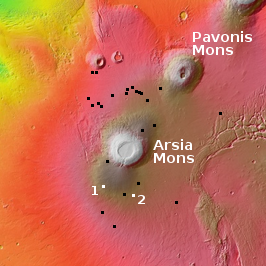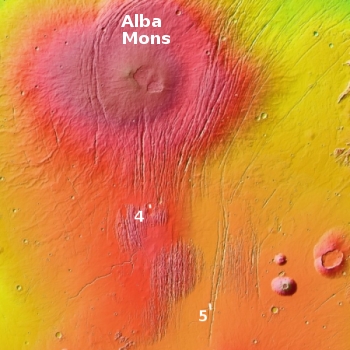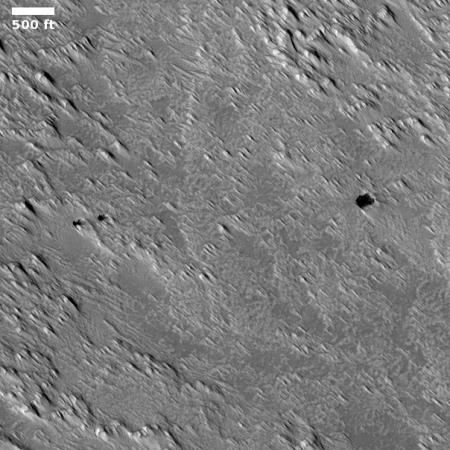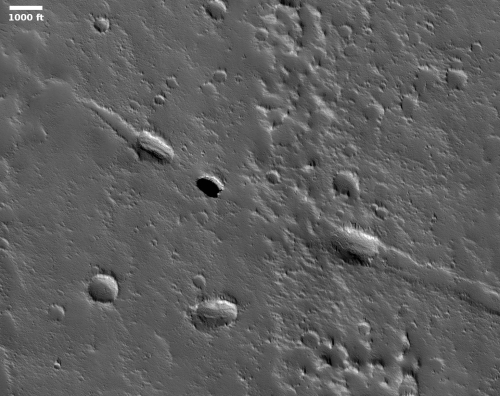More Martian pits!
Though the number of new pictures showing pits and possible caves from the high resolution camera on Mars Reconnaissance Orbiter (MRO) has significantly tailed off in the past year, as I noted in my previous post on Martian pits in September, the pictures are still rolling in. This post will highlight five new photos and the pits therein.
The first two, on the right, are both located on the southern flanks of the giant volcano Arsia Mons, where many such pits are found. They were taken respectively on August 16, 2020 and August 27, 2020. The first was a captioned image from MRO’s science team:
In this image, the ceiling of the lava tube collapsed in one spot and made this pit crater. The pit is about 50 meters (150 feet) across, so it’s likely that the underground tube is also at least this big (much bigger than similar caves on the Earth). HiRISE can’t see inside these steep pits because it’s always late afternoon when we pass overhead and the inside is shadowed at that time of day.
What I find most interesting about both images is that the skylights do not occur where you’d expect. In image #1, the meandering rill that suggests an underground lava tube is about 1,000 feet south of the pit. The pit itself seems unrelated to that rill. In image #2, the surface shows no obvious evidence of an underground tube matching the three aligned pits. There is the hint of a narrow depression along the alignment of the three pits, but this could just as easily be evidence of wind-blown dust along that alignment.
In the full image all three pits appear to sit inside a very wide and very shallow northwest-to-southwest depression, but this is hardly certain, and regardless the three pits align in a different direction.
The overview map below provides some context.

The white boxes show the location of these two images. The black boxes show the locations of the many other pits that scientists have identified in the past few years, and have been highlighted in earlier posts since 2018 on Behind the Black. (The full list of previous posts is at the bottom of this article.)
The scatter of pits around Arsia Mons suggests that the pits do not form in connection to any major structural fault or formation, such as the giant major northeast-to-southwest fault that cuts through Arsia Mons and also aligns with the two giant volcanoes to the north, Arcreaus and Pavonis.
Instead, the scatter on the volcanoes slopes suggest they all formed during one of the many eruption events about a billion years ago that formed this volcano, the lava flowing down its flanks with some of that flow going through lava tubes.
No conclusions at this time however are reliable. We have a very poor map of these tubes and the flows that caused them. And that there are so few on the slopes of Pavonis Mons means nothing. The scientists could simply have not yet had time to document or find them.
In a sense, the next image to the right, taken on August 20, 2020 by MRO, illustrates the level of incompleteness of our knowledge. Like the first two pits, this pit is found on the flanks of a different giant volcano, Elysium Mons, located about two thousand miles to the west
Though it appears to be a very typical skylight pit into a lava tube, as is suspected for most of the pits found at Arsia Mons, as far as I can tell this might be the first such pit photographed on the slopes of Elysium Mons by MRO’s high resolution camera. Even if it isn’t, it appears that either lava tube skylights are not found surrounding Elysium Mons (which would be very surprising), or researchers have simply not yet begun to document them.
Or to put it more simply, the data is very incomplete.

The last two images, taken on August 25, 2020 and August 31, 2020 respectively, show pits and sinkholes into voids below, but in both cases the voids are not caused by flowing lava, but by the bulging upward of the ground due to pressure from underground magma, which causes the ground to crack. That cracking causes the voids.
The overview map to the right makes this obvious. The two white boxes, numbered four and five, show the locations of today’s last two images, both found in the cracked region south of the relatively low-relief giant shield volcano Alba Mons, and almost due north of the chain of three giant volcanoes, Arsia, Pavonis, and Arcreaus Mons.
Scientists call these cracks graben. Unlike a rill or lava flow, grabens start and stop suddenly, and were formed here as the magma pushed up, causing the cracks along fault lines, with some sections then slipping downward into those cracks.

To see the full images click here and here.
MRO photos #4 and #5 to the right show this, though more obviously in #5. Here the pits align with a long relatively straight depression.
With #4 the long depression is barely visible, but at the same time it appears strongly that the south end of the bigger pit connects underground with the smaller pit to the south.
The depressions in #5 on Earth would not be called pits, but sinkholes, as the ground appears to be sinking into a larger void below.
One more detail which illustrates why things are never simple. If you click on the full image for #5 you will see that just to the south, off the edge of my cropped section, is another graben, but instead of being angled north/south it lies perpendicular, in a east/west orientation. For some reason there are graben in this area that cross-cut the main north-south trend. Why only here however is a mystery I wouldn’t dare to explain.
All previous pit posts since 2018:
On Christmas Eve 1968 three Americans became the first humans to visit another world. What they did to celebrate was unexpected and profound, and will be remembered throughout all human history. Genesis: the Story of Apollo 8, Robert Zimmerman's classic history of humanity's first journey to another world, tells that story, and it is now available as both an ebook and an audiobook, both with a foreword by Valerie Anders and a new introduction by Robert Zimmerman.
The print edition can be purchased at Amazon or from any other book seller. If you want an autographed copy the price is $60 for the hardback and $45 for the paperback, plus $8 shipping for each. Go here for purchasing details. The ebook is available everywhere for $5.99 (before discount) at amazon, or direct from my ebook publisher, ebookit. If you buy it from ebookit you don't support the big tech companies and the author gets a bigger cut much sooner.
The audiobook is also available at all these vendors, and is also free with a 30-day trial membership to Audible.
"Not simply about one mission, [Genesis] is also the history of America's quest for the moon... Zimmerman has done a masterful job of tying disparate events together into a solid account of one of America's greatest human triumphs."--San Antonio Express-News
Though the number of new pictures showing pits and possible caves from the high resolution camera on Mars Reconnaissance Orbiter (MRO) has significantly tailed off in the past year, as I noted in my previous post on Martian pits in September, the pictures are still rolling in. This post will highlight five new photos and the pits therein.
The first two, on the right, are both located on the southern flanks of the giant volcano Arsia Mons, where many such pits are found. They were taken respectively on August 16, 2020 and August 27, 2020. The first was a captioned image from MRO’s science team:
In this image, the ceiling of the lava tube collapsed in one spot and made this pit crater. The pit is about 50 meters (150 feet) across, so it’s likely that the underground tube is also at least this big (much bigger than similar caves on the Earth). HiRISE can’t see inside these steep pits because it’s always late afternoon when we pass overhead and the inside is shadowed at that time of day.
What I find most interesting about both images is that the skylights do not occur where you’d expect. In image #1, the meandering rill that suggests an underground lava tube is about 1,000 feet south of the pit. The pit itself seems unrelated to that rill. In image #2, the surface shows no obvious evidence of an underground tube matching the three aligned pits. There is the hint of a narrow depression along the alignment of the three pits, but this could just as easily be evidence of wind-blown dust along that alignment.
In the full image all three pits appear to sit inside a very wide and very shallow northwest-to-southwest depression, but this is hardly certain, and regardless the three pits align in a different direction.
The overview map below provides some context.

The white boxes show the location of these two images. The black boxes show the locations of the many other pits that scientists have identified in the past few years, and have been highlighted in earlier posts since 2018 on Behind the Black. (The full list of previous posts is at the bottom of this article.)
The scatter of pits around Arsia Mons suggests that the pits do not form in connection to any major structural fault or formation, such as the giant major northeast-to-southwest fault that cuts through Arsia Mons and also aligns with the two giant volcanoes to the north, Arcreaus and Pavonis.
Instead, the scatter on the volcanoes slopes suggest they all formed during one of the many eruption events about a billion years ago that formed this volcano, the lava flowing down its flanks with some of that flow going through lava tubes.
No conclusions at this time however are reliable. We have a very poor map of these tubes and the flows that caused them. And that there are so few on the slopes of Pavonis Mons means nothing. The scientists could simply have not yet had time to document or find them.
In a sense, the next image to the right, taken on August 20, 2020 by MRO, illustrates the level of incompleteness of our knowledge. Like the first two pits, this pit is found on the flanks of a different giant volcano, Elysium Mons, located about two thousand miles to the west
Though it appears to be a very typical skylight pit into a lava tube, as is suspected for most of the pits found at Arsia Mons, as far as I can tell this might be the first such pit photographed on the slopes of Elysium Mons by MRO’s high resolution camera. Even if it isn’t, it appears that either lava tube skylights are not found surrounding Elysium Mons (which would be very surprising), or researchers have simply not yet begun to document them.
Or to put it more simply, the data is very incomplete.

The last two images, taken on August 25, 2020 and August 31, 2020 respectively, show pits and sinkholes into voids below, but in both cases the voids are not caused by flowing lava, but by the bulging upward of the ground due to pressure from underground magma, which causes the ground to crack. That cracking causes the voids.
The overview map to the right makes this obvious. The two white boxes, numbered four and five, show the locations of today’s last two images, both found in the cracked region south of the relatively low-relief giant shield volcano Alba Mons, and almost due north of the chain of three giant volcanoes, Arsia, Pavonis, and Arcreaus Mons.
Scientists call these cracks graben. Unlike a rill or lava flow, grabens start and stop suddenly, and were formed here as the magma pushed up, causing the cracks along fault lines, with some sections then slipping downward into those cracks.

To see the full images click here and here.
MRO photos #4 and #5 to the right show this, though more obviously in #5. Here the pits align with a long relatively straight depression.
With #4 the long depression is barely visible, but at the same time it appears strongly that the south end of the bigger pit connects underground with the smaller pit to the south.
The depressions in #5 on Earth would not be called pits, but sinkholes, as the ground appears to be sinking into a larger void below.
One more detail which illustrates why things are never simple. If you click on the full image for #5 you will see that just to the south, off the edge of my cropped section, is another graben, but instead of being angled north/south it lies perpendicular, in a east/west orientation. For some reason there are graben in this area that cross-cut the main north-south trend. Why only here however is a mystery I wouldn’t dare to explain.
All previous pit posts since 2018:
On Christmas Eve 1968 three Americans became the first humans to visit another world. What they did to celebrate was unexpected and profound, and will be remembered throughout all human history. Genesis: the Story of Apollo 8, Robert Zimmerman's classic history of humanity's first journey to another world, tells that story, and it is now available as both an ebook and an audiobook, both with a foreword by Valerie Anders and a new introduction by Robert Zimmerman.
The print edition can be purchased at Amazon or from any other book seller. If you want an autographed copy the price is $60 for the hardback and $45 for the paperback, plus $8 shipping for each. Go here for purchasing details. The ebook is available everywhere for $5.99 (before discount) at amazon, or direct from my ebook publisher, ebookit. If you buy it from ebookit you don't support the big tech companies and the author gets a bigger cut much sooner.
The audiobook is also available at all these vendors, and is also free with a 30-day trial membership to Audible.
"Not simply about one mission, [Genesis] is also the history of America's quest for the moon... Zimmerman has done a masterful job of tying disparate events together into a solid account of one of America's greatest human triumphs."--San Antonio Express-News




